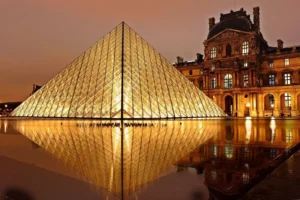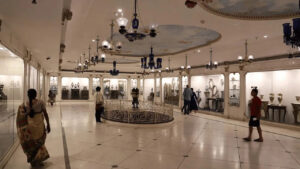
Blogs
The Role of Planetariums in Science Museums
Planetariums play a pivotal role in science museums, serving as immersive theatres that bring the cosmos closer to the public. They offer educational and entertaining shows about astronomy and the night sky, enhancing science literacy and inspiring curiosity about the universe.
Evolution of Planetarium Technology
Over the years, planetarium technology has evolved significantly:
- Opto-Mechanical Projectors: These traditional devices use mechanical systems to project star fields onto domed ceilings, simulating the night sky with remarkable accuracy. Brands like ZEISS have been pioneers in this field, offering a range of optical-mechanical projectors for domes of various sizes.
- Digital Projectors: Modern planetariums increasingly utilize digital projection systems capable of displaying not only stars but also complex astronomical data and immersive visualizations. This technology allows for real-time manipulation of data, enabling researchers and audiences to explore the universe interactively.
Key Components of Planetarium Systems
A comprehensive planetarium setup includes several critical components:
- Projection Systems: High-resolution digital projectors capable of rendering detailed astronomical visuals. Leading brands in this domain include Evans & Sutherland, known for their advanced digital planetarium projection systems.
- Audio Systems: State-of-the-art surround sound systems that provide an immersive auditory experience, complementing the visual display.
- Content Libraries: Extensive collections of astronomical data, educational films, and interactive presentations that can be tailored to diverse audiences.

Integration of Advanced Technologies
The incorporation of cutting-edge technologies has transformed planetarium experiences:
- Artificial Intelligence (AI): AI enhances interactive exhibits, allowing for personalized learning experiences and real-time data analysis.
- Virtual Reality (VR): VR enables visitors to embark on simulated space journeys, offering a hands-on understanding of complex astronomical concepts.
- Interactive Installations: Features like interactive LED walls and holographic displays engage visitors, making learning both fun and informative.
Benefits of Planetariums in Science Museums
Planetariums offer numerous advantages:
- Educational Impact: They serve as powerful tools for science communication, enhancing understanding of astronomy and related sciences.
- Visitor Engagement: The immersive environment captivates audiences, increasing foot traffic and repeat visits.
- Versatility: Beyond astronomy, planetariums can host a variety of educational programs, including multimedia exhibitions and thematic presentations.
Design and Planning Considerations
Designing an effective planetarium involves:
- Spatial Design: Creating a dome structure that provides optimal viewing angles and acoustics.
- Technical Infrastructure: Integrating advanced projection and audio systems seamlessly into the architectural design.
- Content Curation: Developing engaging and informative programs that cater to diverse audiences.
Peach Prime Consultancy’s Expertise
At Peach Prime Consultancy, we specialize in:
- Museum Planning: Offering comprehensive master planning services for science museums and planetariums.
- Design Solutions: Providing innovative design solutions that incorporate the latest technologies to create immersive experiences.
- Exhibit Curation: Curating engaging content that educates and inspires visitors.
- Technical Integration: Ensuring seamless integration of advanced projection systems, audio equipment, and interactive installations.
Our engineering team works closely with clients to conceptualize and execute planetarium projects, enhancing visitor engagement and educational impact. Whether in New Delhi, Mumbai, Bengaluru, Chennai, Kolkata, Hyderabad, Ahmedabad, Pune, Surat, Jaipur, Lucknow, Kanpur, Nagpur, Indore, Thane, Bhopal, Patna, Vadodara, Ludhiana, Agra, Nashik, Meerut, Rajkot, Kalyan-Dombivli, Varanasi, Srinagar, Amritsar, Allahabad (Prayagraj), Visakhapatnam, Jodhpur, Madurai, Coimbatore, Gwalior, Vijayawada, Guwahati, Mysore, Kota, Ranchi, Jabalpur, Bareilly, Chandigarh, Tiruchirappalli, Noida, Ghaziabad, Dhanbad, Raipur, Aurangabad, Bhubaneswar, Dehradun, Udaipur, or Mangalore, planetariums are integral components of science museums, bridging the gap between complex astronomical phenomena and public understanding. With advancements in technology and thoughtful design, they continue to inspire and educate future generations.

1. Hayden Planetarium (American Museum of Natural History, New York, USA)
Key Features:
- Digital Projection System: Equipped with cutting-edge technology from Evans & Sutherland, the Hayden Planetarium offers ultra-high-definition projections of the universe.
- Space Show: Regularly updated immersive shows explore topics like dark matter and exoplanets.
- AI Integration: Interactive exhibits powered by AI enhance visitor engagement.
- Customizable Content: The planetarium tailors its programs to audiences ranging from school groups to researchers.
2. Morrison Planetarium (California Academy of Sciences, San Francisco, USA)
Key Features:
- 360-Degree Dome: The world’s largest all-digital planetarium dome offers unparalleled immersive experiences.
- Real-Time Data: Uses up-to-date astronomical data to create accurate, real-time visualizations of the cosmos.
- Surround Sound: State-of-the-art audio systems complement the visual experience.
- Educational Outreach: Programs tailored for schools, families, and astronomy enthusiasts.
3. Nagoya City Science Museum Planetarium (Nagoya, Japan)
Key Features:
- Largest Dome: With a diameter of 35 meters, it holds the Guinness World Record for the largest planetarium dome.
- Hybrid Projector System: Combines optical-mechanical and digital projection systems for unmatched clarity.
- Interactive Installations: Visitors can engage with hands-on exhibits before and after shows.
- Cultural Programs: Offers a mix of traditional astronomy and Japanese stargazing stories.

4. Adler Planetarium (Chicago, USA)
Key Features:
- Interactive LED Walls: Visitors can explore the universe through touch-based visualizations.
- Virtual Reality Experiences: Allows participants to virtually “fly” through the solar system.
- Themed Shows: Regular shows such as “Destination Solar System” blend storytelling with science.
- Historic Artifacts: Houses one of the largest collections of historical astronomical instruments.
5. Zeiss-Großplanetarium (Berlin, Germany)
Key Features:
- ZEISS Hybrid Projection System: Incorporates both digital and optical-mechanical projectors for a high-quality celestial display.
- Holographic Displays: Utilizes holography to simulate celestial phenomena in stunning detail.
- Thematic Presentations: Covers a wide range of topics, from black holes to climate change’s effects on astronomy.
- Sustainability Design: The facility is powered by green energy, reflecting its commitment to environmental education.
Why Choose Peach Prime Consultancy
At Peach Prime Consultancy, we specialize in designing innovative museums that optimize space, enhance visitor flow, and create immersive, educational experiences. Our services include comprehensive budget planning and cost estimation to ensure your project aligns with financial expectations, with a detailed breakdown of the total project cost. From conceptualizing interactive exhibits and digital installations to creating engaging storytelling spaces, our team combines creativity and expertise to craft museums that inspire and educate visitors of all ages.
We extend our services to iconic destinations such as Varanasi, Amritsar, Haridwar, Rishikesh, Tirupati, Bodh Gaya, Puri, Ajmer, Shirdi, Dwarka, Mathura, Vrindavan, Kedarnath, Badrinath, Rameswaram, Kanchipuram, Mecca Masjid, Sanchi, Kailash Mansarovar, Somnath, Srirangam, Vaishno Devi, Golden Temple, Kashi Vishwanath, Jama Masjid, Khajuraho, Puri Jagannath Temple, Shankaracharya Temple, Pushkar, Tirumala, Palani, Kumbh Mela, Nabadwip, Banaras Hindu University, Gurudwara Bangla Sahib, Sabarimala, Tirthan Valley, Hampi, Patal Bhuvaneshwar, Shakti Peeths, Kamakhya Temple, Shri Siddhivinayak, Dakshineswar Kali Temple, Naina Devi Temple, Jwalamukhi Temple, Mahakaleshwar Temple, Somnath Temple, Tiruvannamalai, Omkareshwar, and Lingaraj Temple.
Contact us today to bring your vision of an engaging and inspiring museum to life and create experiences that leave a lasting impact on your visitors!












